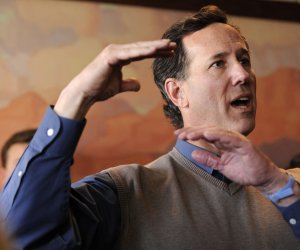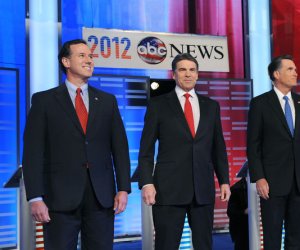The Iowa caucuses are an electoral event in which residents of the U.S. state of Iowa meet in precinct caucuses in all of Iowa's 1,774 precincts and elect delegates to the corresponding county conventions. There are 99 counties in Iowa and thus 99 conventions. These county conventions then select delegates for both Iowa's Congressional District Convention and the State Convention, which eventually choose the delegates for the presidential nominating conventions (the national conventions). The 2012 Iowa Caucuses were held on Tuesday, January 3, 2012.[1] The Iowa caucuses are noteworthy for the amount of media attention they receive during U.S. presidential election years. Since 1972, the Iowa caucuses have been the first major electoral event of the nominating process for President of the United States. Although only about 1% of the nation's delegates are chosen by the Iowa State Convention (28 Republican delegates in 2012, assigned proportionately), the Iowa caucuses have served as an early indication of which candidates for president might win the nomination of their political party at that party's national convention, and which ones could drop out for lack of support. History The Iowa Caucuses are commonly recognized as the first step in the U.S. presidential nomination process for both the Democratic and the Republican Parties. They came to national attention in 1972 with a series of articles in The New York Times on how non-primary states choose their delegates for the national conventions. Democratic operative, Norma S. Matthews, state co-chair of the George McGovern campaign, helped engineer the early-January start for Iowa. McGovern finished second to Edmund Muskie in the first early Iowa caucuses, but the momentum was sufficient for an ultimate Democratic nomination in 1972 for McGovern in Miami. Four years later, the Iowa Republican Party scheduled its party caucuses on the same date as the Democrats'. In 1976, an uncommitted slate received the most support, followed by former Georgia governor Jimmy Carter, who came in a distant second, but won the most votes of any actual candidate. With no dominant front runner at the time, Carter was able to use the publicity of his "win" to achieve victory in the New Hampshire primary, and then to win his party's nomination and eventually the Presidency. Since then, Presidential candidates have increased their focus on winning the Iowa caucus. In 1980, Republicans began the tradition of holding a straw poll at their caucuses, giving the appearance of a primary election. George H. W. Bush campaigned extensively in Iowa, defeating Ronald Reagan, but ultimately failed to win the nomination. While they have been a financial boon to the state, the political value of the Iowa caucuses has gone up and down over the years. In 1988, for example, the candidates who eventually won the nominations of both parties came in third in Iowa. In elections without a sitting president or vice president, the Iowa winner has gone on to the nomination only about half the time (see below). When Iowa senator Tom Harkin ran for the Democratic nomination in 1992, none of the other Democratic candidates chose to compete in Iowa, which minimized its importance in the nomination process. President George H. W. Bush was unopposed on the Republican side. Both parties have tried to preserve the position of Iowa and New Hampshire in their nominating schedules.[2][3] However, Alaska and Hawaii have had their Republican caucuses before Iowa in the past, and in 1988 the Hawaii victory of Pat Robertson and the 1996 Louisiana victory of Pat Buchanan over Senator Phil Gramm had a significant impact on the results in Iowa. The caucuses are closely followed by the media and can be an important factor in determining who remains in the race and who drops out. However, the only non-incumbent candidates to win their party's caucus and go on to win the general election were George W. Bush in 2000 and Barack Obama in 2008. Neither Reagan nor Bill Clinton won prior to their first terms. No incumbent President has run opposed in his own party's caucus since Jimmy Carter in 1980. In the months leading up to the 2004 caucus, predictions showed candidates Dick Gephardt and Howard Dean neck-and-neck for first place, with John Kerry and John Edwards far behind them. Negative campaign ads attacking each other by the two front runners soured the voters on them, and a last minute decision by Kerry to put all his remaining money in Iowa swung voters towards him. Gephardt's presidential hopes were dashed and Dean's badly battered, as Kerry went on to become the third non-incumbent to win both Iowa and New Hampshire (after Edmund Muskie in 1972 and Al Gore in 2000). For the 2012 Iowa caucuses, although running unopposed, President Barack Obama garnered Democrat support via a video conference to Democrats in caucus.[4]
It uses material from the Wikipedia article "Iowa Caucus."





 Former winners of the Iowa caucus
Former winners of the Iowa caucus  The 2012 Republican Caucus in Iowa
The 2012 Republican Caucus in Iowa  The primary race in Iowa continues
The primary race in Iowa continues  GOP presidential debate in Iowa
GOP presidential debate in Iowa  Republican Presidential Debate in Des Moines
Republican Presidential Debate in Des Moines